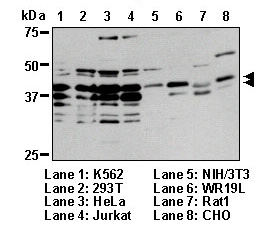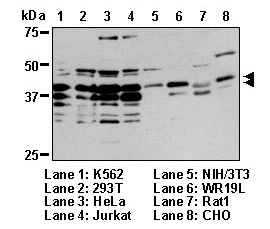Anti-TIA1 (Human) pAb
| Code | Size | Price |
|---|
| MBL-RN014P | 200 ul | £404.00 |
Quantity:
Prices exclude any Taxes / VAT
Overview
Host Type: Rabbit
Antibody Clonality: Polyclonal
Regulatory Status: RUO
Target Species:
- Hamster
- Human
- Mouse
- Rat
Applications:
- Immunoprecipitation (IP)
- RIP
- Western Blot (WB)
Shipping:
4°C
Storage:
-20°C
Images
Documents
Further Information
Applications:
WB - 1:1,000 for chemiluminescence detection system IP - 5 ?g/250 ?L of cell extract from
2.5 x 106 cells RIP - 15 ug/500 uL of cell extract from 6 x 106 cells
Background:
T Cell intracellular antigen-1 (TIA1), an apoptosis promoting factor, is a RNA binding protein which associates with subsets of mRNAs bearing U-rich sequences in their 3?-UTRs and shuttles between nucleus and cytoplasm. TIA1 possesses three RNA recognition motifs (RRMs). RRM2 and the first half of the auxiliary region are necessary for nuclear accumulation whereas RRM3 mediates nuclear export. TIA1 regulates splicing of alternatively spliced pre-mRNAs including Fas, msl-2, FGFR-2, calsitonin/CGRP in nucleus. In cytoplasm, TIA1 regulates translation of various mRNAs, include TNF-α, Cox-2, HMMP-13 and β2-adrenergic receptor, by binding to AU-rich elements (AREs) located in these mRNA 3? untranslated regions (3?UTRs). In addition to the translational silencing, TIA1 plays a role in the cellular response to environmental stress by promoting the assembly of a non-canonical 48S preinitiation complex that is the core component of cytoplasmic stress granules (SG). Like other mRNA turnover and translation regulators such as AUF-1, HuR, KSRP and NF90, TIA1 also associates its cognate mRNA and transcripts of other RBPs.
Concentration:
1 mg/mL
Description:
Posttranscriptional regulation of gene expression is a ribonucleoprotein-driven process, which involves RNA binding proteins (RBPs) and non-coding RNAs that affect splicing, nuclear export, subcellular localization, mRNA decay and translation. The RNP Immunoprecipitation-Chip (RIP-Chip), RIP-Seq and RIP-RTPCR allow the identification of multiple RNA targets of RBPs globally and within the context of a cell extract. Antibodies specific to the RNA binding protein of interest are used to co-immunoprecipitate the RNA binding protein and the associated subset of mRNAs. The mRNA content is interrogated using standard microarray or sequencing technology. RIP-Certified Antibody is validated for use in RNP Immunoprecipitation (RIP) in conjunction with the RIP-Assay kit distributed from MBLI. Its ability to immunoprecipitate mRNAs and RBPs complex was confirmed by quantitative and qualitative analysis on NanoDrop, Bioanalyzer and RT-PCR or microarray.
Formulation:
200 ul volume of PBS containing 50% glycerol, pH 7.2. No preservative is contained.
Gene IDs:
Human: 7072 Mouse: 21841
Immunogen Translated:
Peptide bond synthesis NGSMLPNQPSGYRVAGYETQ KLH (367-386 aa)
Reactivity:
This antibody reacts with human TIA1 (~43 kDa) on Western blotting, Immunoprecipitation and RNP Immunoprecipitation.
Shelf Life:
1 year
Source:
This antibody was purified from rabbit serum by affinity column chromatography. The rabbit was immunized with KLH conjugated synthetic peptide, NGSMLPNQPSGYRVAGYETQ corresponding to 367-386 aa.
Target:
TIA1
References
1)
Pullmann, Jr., R., et al., Mol. Cell Biol. 27, 6265-6278 (2007)
2)
Zhang, T., et al., J. Cell Sci. 118, 5453-5463 (2005)
3)
Kandasamy, K., et al., J. Biol. Chem. 280, 1931-1943 (2005)








